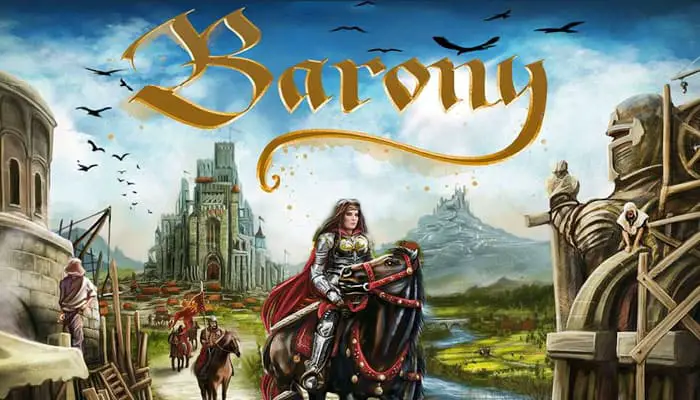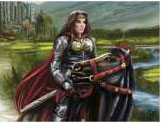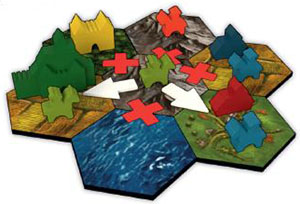
At the farthest reaches of the Empire, four barons fight for the power. With their armies of knights, they extend their territories and build villages, strongholds and cities. At the end of this race for power, one of them will become King.

Components
- 36 Territory tiles (Mountains, Forests, Plains, Fields, Lakes)
- 1 scoreboard
- 80 Resource tokens
- 1 First Player token
- 25 knights
- 20 cities
- 8 strongholds
- 52 villages
- 4 score counters
- 4 Player Reference sheets
Object of the Game
Each player must conquer territories, build and protect villages, strongholds, and cities. When at least one player becomes a Duke, the player with the most Victory points is crowned King and wins the game.
Game Elements
Land Tiles
Each tile is made up of 3 independent hexagons. Each hexagon represents one space of the board game and is one of the five types of land. Each land type, except the Lake, is associated with one Resource token:

-
Mountain: One pawn placed in a mountain space is enough to keep other players from entering.
-
Forest: No city can be placed or built in a forest space.
-
Plain and fields: These are the most prosperous territories. They make it easier to gain a rank of nobility when you take the "Noble Title" action.
-
Lake: This space cannot be crossed or occupied by any pawns during the game.
Pawns

Cities
- Defense: A space occupied by a city is inaccessible to opposing knights.
- New city: A village can become a city. Each new city earns 10 victory points.
- Action Recruitment: Knights are recruited in cities.
Knights

- Recruitment: Knights are recruited in a city.
- Action Movement: Knights move from one space to another to claim territory, attack opponents, or defend.
- Construction: One knight can be replaced with a village or a stronghold.
- Defense: One knight can be destroyed by two opposing pawns of the same color.
Villages

- Construction: A player can replace one knight on the board with a new village.
- Action New city: Cities are always constructed from villages.
- Defense: One village can be destroyed by two opposing knights of the same color.

Strongholds
- Construction: A player can replace one knight on the board with a new stronghold.
- Defense: A space occupied by a stronghold is inaccessible to opposing knights.
Setup
Take 9 random tiles per player and place them randomly to build a game board
1. If there are fewer than 4 players, unused tiles should be put back in the game box.Place all of the Resource tokens together next to the game board
2. This is the resource bank.Each player chooses one color and places in front of him the corresponding pawns: 5 cities, 2 strongholds, 7 knights, and 14 villages
3and also a Player Reference sheet4.Each player will place 3 cities and 3 knights
5as explained on the right.Place the score counters on the 0 space of the scoreboard
6.The youngest player chooses a first player. This player takes the First Player token. He may choose himself as the first player
7.

Arrangement of the first cities and knights
After a moment of reflection in which he examines the board, the first player places one city and one knight in the space of his choice.
Then, in clockwise order, each player does the same except for the last player, who places 3 cities instead of 1, with one knight in each of them.
Then, proceeding counterclockwise, each player other than the last player then places 2 cities with 1 knight in each of them.
Thus, each player will start his first turn with 3 cities, each with one knight, in three different spaces of the board. The remaining pawns are each player's reserve.
Restrictions
- No cities are allowed in lake spaces
- No cities are allowed in forest spaces
- No cities may be placed in the same space or in a space adjacent to another city
Game Play
The game is a succession of turns which are played in clockwise order. On his turn, a player can take ONE and only one of the following six actions:
- Recruitment
- Movement
- Construction
- New city
- Expedition
- Noble tile
A. Recruitment

Choose one and only one city and place up to 2 knights taken from the reserve into the same space as the city. If the city's space is adjacent to one or more lake(s), you can place up to 3 knights instead.
If you have no knights in your reserve, you cannot take the recruit action.

The red city is on the edge of a lake. Thus the red player recruits 3 knights.
B. Movement

Move 1 or 2 of your knights to an adjacent space.
The two moves are completely independent (the starting and destination spaces of the knights can be different). However, you cannot move the same knight twice.
There is no limit to the number of your knights that can be present in the same space.
 The blue player moves two knights. |
Restrictions
A knight cannot move to the following spaces:
- A lake space
- A space with an opponent's city or stronghold
- A space containing at least 2 pawns belonging to the same opponent (2 knights or 1 knight + 1 village)
- A mountain space with an opponent's pawn in it.
 The green knight can only move to two spaces |
Coexistence and conflict
In a single space, pawns of different players can coexist as long as a player doesn't have more than one pawn (knight or village) in this space.
If a player already present in a space moves another knight into that space, he destroys all opposing pawns in that space.
Destroyed knights and villages are returned to their owners' reserves.
Important: When a player destroys an opponent's village, he takes from that player a Resource token.
The attacking player chooses the Resource token. If the attacked player has no Resource tokens left, the attacker takes nothing. No Resource token is earned when a player destroys an opponent's knight.

The yellow player moves a knight to a space which already contains one of his knights, a red knight and a blue village.

With his 2 knights he destroys all of his opponents' pawns, and takes a Resource token from the blue player.
C. Construction

Replace all or any of your knights on the game board with a village or stronghold from your reserve.
Knights replaced in this way are returned to your reserve. For each build, you immediately earn one Resource token corresponding to the land type of the space.
Notes :
If two knights of the same color are in the same space, only one of them will be replaced.
Buildings are limited to the quantity in your reserve. If you have no strongholds or villages left, you cannot build any more. You cannot remove one of your own buildings from the board.

There are only two spaces where the red player can build strongholds or villages.

He replaces one knight with a strong- hold and the other with a village. He then takes one Mountain and one Fields Resource token, corresponding to the spaces where he just built.
Restrictions
You cannot build:
- If there is already a building on the space (village, stronghold, or city) regardless of who the owner is.
- If an opponent's knight is present on the space.
Resource Tokens
Each of the 4 different tokens are worth Resource points which can be used during the Action E - Noble title (gold number), or counted and added to the player's score at the end of the game (silver number).

D. New City

Replace one of your villages with a city from your reserve (this is only possible if you have a city in your reserve).
The replaced village is returned to your reserve.
When you build a new city, you immediately earn 10 victory points: move your score counter down one space.

In this situation, only two villages can be replaced with cities.

The blue player replaces one of his villages with a city and earns 10 victory points. He now has 25 points.
Restrictions
You cannot build a city:
- If the village is in a forest space.
- If the village is in a space adjacent to a space containing a city (regardless of who owns the city).
- If an opponent's knight is present on the space.
E. Expedition

Take two knights from your reserve. One of them is permanently removed from the game (put it back in the game box) and place the other in a free space of your choice on the edge of the game board.

The green player removes one of his Reserve knights from the game and then places another in the free Forest space on the edge of the game board, behind the red player's villages.
Restrictions
You cannot place the knight:
- In a lake space.
- In a space containing another pawn (knight or building) regardless of its owner.
F. Noble Title

All players start the game with the title of Baron. They can then become Viscount, Count, Marquis, and then Duke.
Discard a minimum of 15 Resource points to acquire a higher Noble title, and then move your score counter one space to the right on the scoreboard.
Discarded Resource tokens are returned to the resource bank. Watch out!
The resource bank doesn't give change if more than 15 Resource points are spent. No one can advance by more than one rank at a time, even if someone possesses enough Resource points.

The yellow player spends 16 Resource points and moves one space to the right.
He has advanced from Count to Mar- quis, and now has 45 points.
End of the Game
When one player becomes a Duke (the last column on the scoreboard with the 60, 70, and 80 values), continue until the end of the round so that each player has played the same number of turns.
Each player adds his unused Resource points (silver number) to his Victory points on the scoreboard. The player with the most points becomes the King and wins the game.
In case of a tie, it is the tied player who is furthest from the first player in turn order who wins.

The yellow player has 70 points on the score board. He has also 3 Resource tokens left with 4 points on them.
His final score will be 74 points.
Continue Reading






